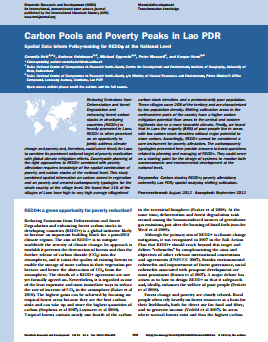Carbon pools and poverty peaks in Lao PDR
Summary
Reducing Emissions from Deforestation and forest Degradation and enhancing forest carbon stocks in developing countries (REDD+) is heavily promoted in Laos. REDD+ is often perceived as an opportunity to jointly address climate change and poverty and, therefore, could come timely for Lao sto combine its prominent national target of poverty eradication with global climate mitigation efforts.
Countrywide planning of the right approaches to REDD+ combined with poverty alleviation requires knowledge of the spatial combination of poverty and carbon stocks at the national level. This study combined spatial information on carbon stored in vegetation and on poverty and created carbon-poverty typologies for the whole country at the village level. We found that 11% of the villages of Laos have high to very high average village-level carbon stock densities and a predominantly poor population. These villages cover 20% of the territory and are characterizedby low population density. Shifting cultivation areas in the northwestern parts of the country have a higher carbon mitigation potential than areas in the central and eastern highlands due to a more favorable climate. Finally, we found that in Laos the majority (58%) of poor people live in area swith low carbon stock densities without major potential to store carbon. Accordingly, REDD+ cannot be considered a core instrument for poverty alleviation. The carbon-poverty typologies presented here provide answers to basic questions related to planning and managing of REDD+. They could serveas a starting point for the design of systems to monitor both socioeconomic and environmental development at the national level.


 Twitter
Twitter Google+
Google+ Facebook
Facebook LinkedIn
LinkedIn Digg
Digg del.icio.us
del.icio.us StumbleUpon
StumbleUpon